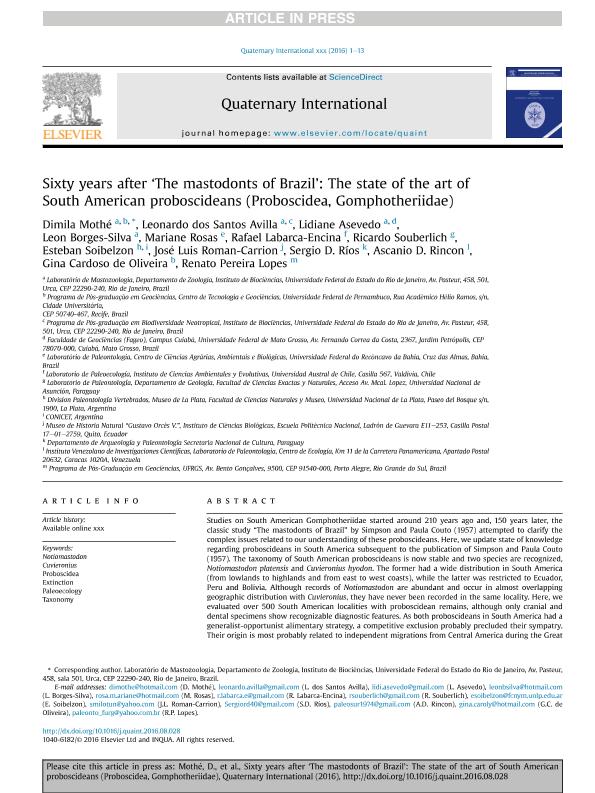Mostrar el registro sencillo del ítem
dc.contributor.author
Mothé, Dimila
dc.contributor.author
dos Santos Avilla, Leonardo
dc.contributor.author
Asevedo, Lidiane
dc.contributor.author
Borges Silva, Leon
dc.contributor.author
Rosas, Mariane
dc.contributor.author
Labarca Encina, Rafael
dc.contributor.author
Souberlich, Ricardo
dc.contributor.author
Soibelzon, Esteban

dc.contributor.author
Roman Carrion, José Luis
dc.contributor.author
Ríos, Sergio Daniel

dc.contributor.author
Rincon, Ascanio D.
dc.contributor.author
de Oliveira, Gina Cardoso
dc.contributor.author
Lopes, Renato Pereira
dc.date.available
2018-06-13T21:14:35Z
dc.date.issued
2017-07
dc.identifier.citation
Mothé, Dimila; dos Santos Avilla, Leonardo; Asevedo, Lidiane; Borges Silva, Leon; Rosas, Mariane; et al.; Sixty years after ‘The mastodonts of Brazil’: The state of the art of South American proboscideans (Proboscidea, Gomphotheriidae); Pergamon-Elsevier Science Ltd; Quaternary International; 443; 7-2017; 52-64
dc.identifier.issn
1040-6182
dc.identifier.uri
http://hdl.handle.net/11336/48585
dc.description.abstract
Studies on South American Gomphotheriidae started around 210 years ago and, 150 years later, the classic study "The mastodonts of Brazil" by Simpson and Paula Couto (1957) attempted to clarify the complex issues related to our understanding of these proboscideans. Here, we update state of knowledge regarding proboscideans in South America subsequent to the publication of Simpson and Paula Couto (1957). The taxonomy of South American proboscideans is now stable and two species are recognized, Notiomastodon platensis and Cuvieronius hyodon. The former had a wide distribution in South America (from lowlands to highlands and from east to west coasts), while the latter was restricted to Ecuador, Peru and Bolivia. Although records of Notiomastodon are abundant and occur in almost overlapping geographic distribution with Cuvieronius, they have never been recorded in the same locality. Here, we evaluated over 500 South American localities with proboscidean remains, although only cranial and dental specimens show recognizable diagnostic features. As both proboscideans in South America had a generalist-opportunist alimentary strategy, a competitive exclusion probably precluded their sympatry. Their origin is most probably related to independent migrations from Central America during the Great American Biotic Interchange. They are not sister-taxa - Cuvieronius hyodon is sister-taxon of Rhynchotherium, and this clade is closer to Notiomastodon platensis than to the other proboscideans, supporting the hypothesis of independent origins. Notiomastodon platensis has a continuous record from the Early Pleistocene to Early Holocene, when it became extinct, probably due to synergy of human impact and climatic changes during the Pleistocene/Holocene transition. In contrast, extinction of Cuvieronius hyodon happened much earlier, and it was not related to the terminal Pleistocene event that lead the extinction of selected megafauna in South America, including Notiomastodon.
dc.format
application/pdf
dc.language.iso
eng
dc.publisher
Pergamon-Elsevier Science Ltd

dc.rights
info:eu-repo/semantics/openAccess
dc.rights.uri
https://creativecommons.org/licenses/by-nc-sa/2.5/ar/
dc.subject
Cuvieronius
dc.subject
Extinction
dc.subject
Notiomastodon
dc.subject
Paleoecology
dc.subject
Proboscidea
dc.subject
Taxonomy
dc.subject.classification
Meteorología y Ciencias Atmosféricas

dc.subject.classification
Ciencias de la Tierra y relacionadas con el Medio Ambiente

dc.subject.classification
CIENCIAS NATURALES Y EXACTAS

dc.title
Sixty years after ‘The mastodonts of Brazil’: The state of the art of South American proboscideans (Proboscidea, Gomphotheriidae)
dc.type
info:eu-repo/semantics/article
dc.type
info:ar-repo/semantics/artículo
dc.type
info:eu-repo/semantics/publishedVersion
dc.date.updated
2018-06-13T14:16:00Z
dc.journal.volume
443
dc.journal.pagination
52-64
dc.journal.pais
Reino Unido

dc.journal.ciudad
Nueva York
dc.description.fil
Fil: Mothé, Dimila. Universidade Federal do Rio de Janeiro; Brasil. Universidade Federal de Pernambuco; Brasil
dc.description.fil
Fil: dos Santos Avilla, Leonardo. Universidade Federal do Rio de Janeiro; Brasil
dc.description.fil
Fil: Asevedo, Lidiane. Universidade Federal do Rio de Janeiro; Brasil. Universidade Federal de Mato Grosso; Brasil
dc.description.fil
Fil: Borges Silva, Leon. Universidade Federal do Rio de Janeiro; Brasil
dc.description.fil
Fil: Rosas, Mariane. Universidade Federal do Recôncavo da Bahia; Brasil
dc.description.fil
Fil: Labarca Encina, Rafael. Universidad Austral de Chile; Chile
dc.description.fil
Fil: Souberlich, Ricardo. Universidad Nacional de Asunción; Paraguay
dc.description.fil
Fil: Soibelzon, Esteban. Consejo Nacional de Investigaciones Científicas y Técnicas; Argentina. Universidad Nacional de La Plata. Facultad de Ciencias Naturales y Museo. División Paleontología Vertebrados; Argentina
dc.description.fil
Fil: Roman Carrion, José Luis. Museo de Historia Natural “Gustavo Orcés V."; Ecuador
dc.description.fil
Fil: Ríos, Sergio Daniel. Secretaria Nacional de Cultura; Paraguay
dc.description.fil
Fil: Rincon, Ascanio D.. Instituto Venezolano de Investigaciones Científicas; Venezuela
dc.description.fil
Fil: de Oliveira, Gina Cardoso. Universidade Federal de Pernambuco; Brasil
dc.description.fil
Fil: Lopes, Renato Pereira. Universidade Federal do Rio Grande do Sul; Brasil
dc.journal.title
Quaternary International

dc.relation.alternativeid
info:eu-repo/semantics/altIdentifier/doi/https://dx.doi.org/10.1016/j.quaint.2016.08.028
dc.relation.alternativeid
info:eu-repo/semantics/altIdentifier/url/https://www.sciencedirect.com/science/article/pii/S1040618216302993
Archivos asociados
